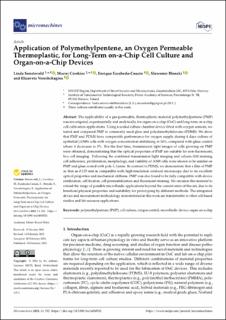| dc.description.abstract | The applicability of a gas-permeable, thermoplastic material polymethylpentene (PMP) was investigated, experimentally and analytically, for organ-on-a-chip (OoC) and long-term on-a-chip cell cultivation applications. Using a sealed culture chamber device fitted with oxygen sensors, we tested and compared PMP to commonly used glass and polydimethylsiloxane (PDMS). We show that PMP and PDMS have comparable performance for oxygen supply during 4 days culture of epithelial (A549) cells with oxygen concentration stabilizing at 16%, compared with glass control where it decreases to 3%. For the first time, transmission light images of cells growing on PMP were obtained, demonstrating that the optical properties of PMP are suitable for non-fluorescent, live cell imaging. Following the combined transmission light imaging and calcein-AM staining, cell adherence, proliferation, morphology, and viability of A549 cells were shown to be similar on PMP and glass coated with poly-L-lysine. In contrast to PDMS, we demonstrate that a film of PMP as thin as 0.125 mm is compatible with high-resolution confocal microscopy due to its excellent optical properties and mechanical stiffness. PMP was also found to be fully compatible with device sterilization, cell fixation, cell permeabilization and fluorescent staining. We envision this material to extend the range of possible microfluidic applications beyond the current state-of-the-art, due to its beneficial physical properties and suitability for prototyping by different methods. The integrated device and measurement methodology demonstrated in this work are transferrable to other cell-based studies and life-sciences applications. | en_US |

